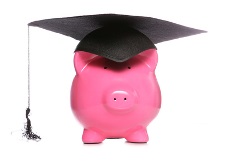One of the most important things you can give your children is a good education. But it doesn’t come cheap – so the sooner you start saving, the better. 
Once upon a time, after you’d paid school fees and uniforms, education costs didn’t extend much beyond stationery, books and lunch money. These days, with expenses like iPads and laptops, extracurricular activities and private tuition, schooling your kids can become a financial burden!
In fact, the Australian Scholarships Group estimates that parents of a child born in 2016 could spend well over $500,000 on their child’s private education in Sydney or Melbourne. Even with public schooling, educational costs for the same child could still add up to more than $70,000.[1]
But don’t panic – there are some simple things you can do to ease the burden.
1. Make a realistic budget
Even if you opt for public education over private, the costs still add up. Make sure your budget factors in things like afterschool care, music lessons, sporting activities and technology upgrades – so you can avoid overstretching.
2. Start saving early
The sooner you begin saving, the longer your money will have to grow. By investing a little now, that growth could be substantial over time – thanks to the multiplying power of compound interest.
For instance, suppose you open a savings account to save for your child’s education when they’re born, with an initial deposit of $5,000. By putting in $40 each week, you could have saved up to $43,605 (including a possible $13,645 in interest) by the time your child heads off to high school.[2]
3. Consider paying off your home faster
On the subject of interest, remember that paying off a debt sooner means reducing the interest you’ll be charged over time. It can also help to free up cash flow to divert to other expenses, such as your child’s education.
Your biggest debt is likely to be your mortgage, so it may be better to pay off as much as you can before the kids start school. It might also be worth choosing a home loan with an offset or redraw facility, just in case you need to access the money later.
4. Think about your investment options
There are all sorts of ways you can invest for your children’s education. For instance, with a high-interest savings account, you can make payments whenever you like and can generally access the money as you need it. On the other hand, shares or managed funds may give you higher returns over the long term – and you can make regular payments into a managed fund which may grow your investment.
Before you do anything, you should seek financial and tax advice to understand the different investment options and associated tax implications.
[1] Australian Scholarships Group, ASG Planning for Education Index 2016.
[2] Calculations made with ASIC MoneySmart Compound Interest Calculator. Calculations assume a $5,000 initial deposit and weekly contributions of $40 over 12 years, with a 5.12% interest rate compounding monthly. Does not take in to account tax payable on interest earned, or fluctuation in interest rates or weekly contributions.
